Exploring Psychological and Social Dynamics in Human Relationships
VerifiedAdded on 2020/05/28
|11
|3075
|71
Essay
AI Summary
This comprehensive analysis explores the intricate dynamics shaping human interactions through various psychological lenses. The discussion begins by addressing self-concept as a pivotal factor influencing individuals' perceptions and behaviors in social contexts. Following this, attribution theory is scrutinized for its role in explaining how people interpret their own and others' actions, thus affecting interpersonal relationships. Attention is then directed towards strategies of resistance to persuasion, highlighting the cognitive mechanisms employed to maintain personal beliefs against external influences. The essay further examines self-presentation techniques used by individuals to shape social perceptions and navigate complex social settings. Finally, the study investigates how these psychological constructs intersect with welfare governance and human resources practices, particularly focusing on marketization and managerialism in social services delivery. By integrating insights from seminal studies and recent scholarly works, this analysis underscores the multifaceted nature of human interactions and their broader societal implications.
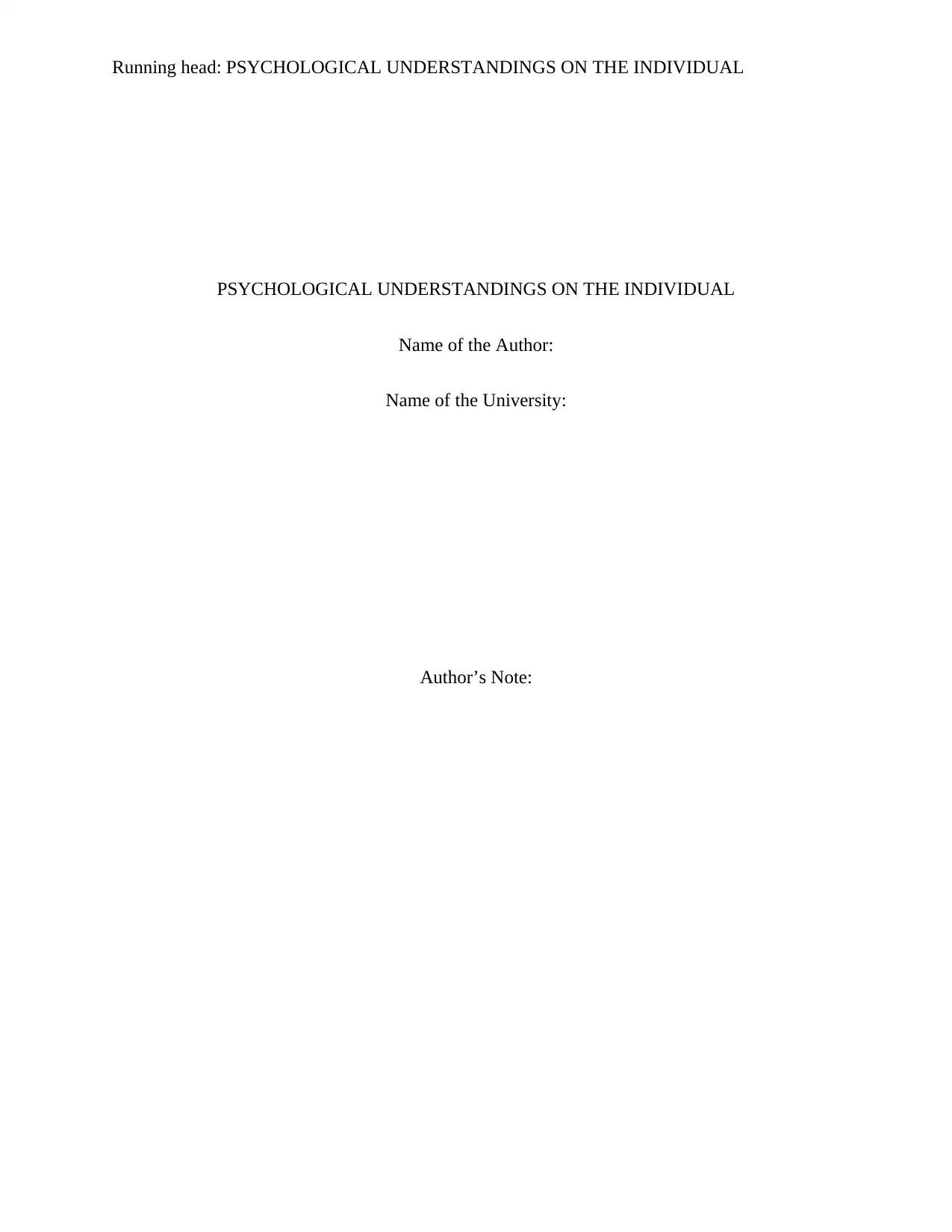
Running head: PSYCHOLOGICAL UNDERSTANDINGS ON THE INDIVIDUAL
PSYCHOLOGICAL UNDERSTANDINGS ON THE INDIVIDUAL
Name of the Author:
Name of the University:
Author’s Note:
PSYCHOLOGICAL UNDERSTANDINGS ON THE INDIVIDUAL
Name of the Author:
Name of the University:
Author’s Note:
Paraphrase This Document
Need a fresh take? Get an instant paraphrase of this document with our AI Paraphraser
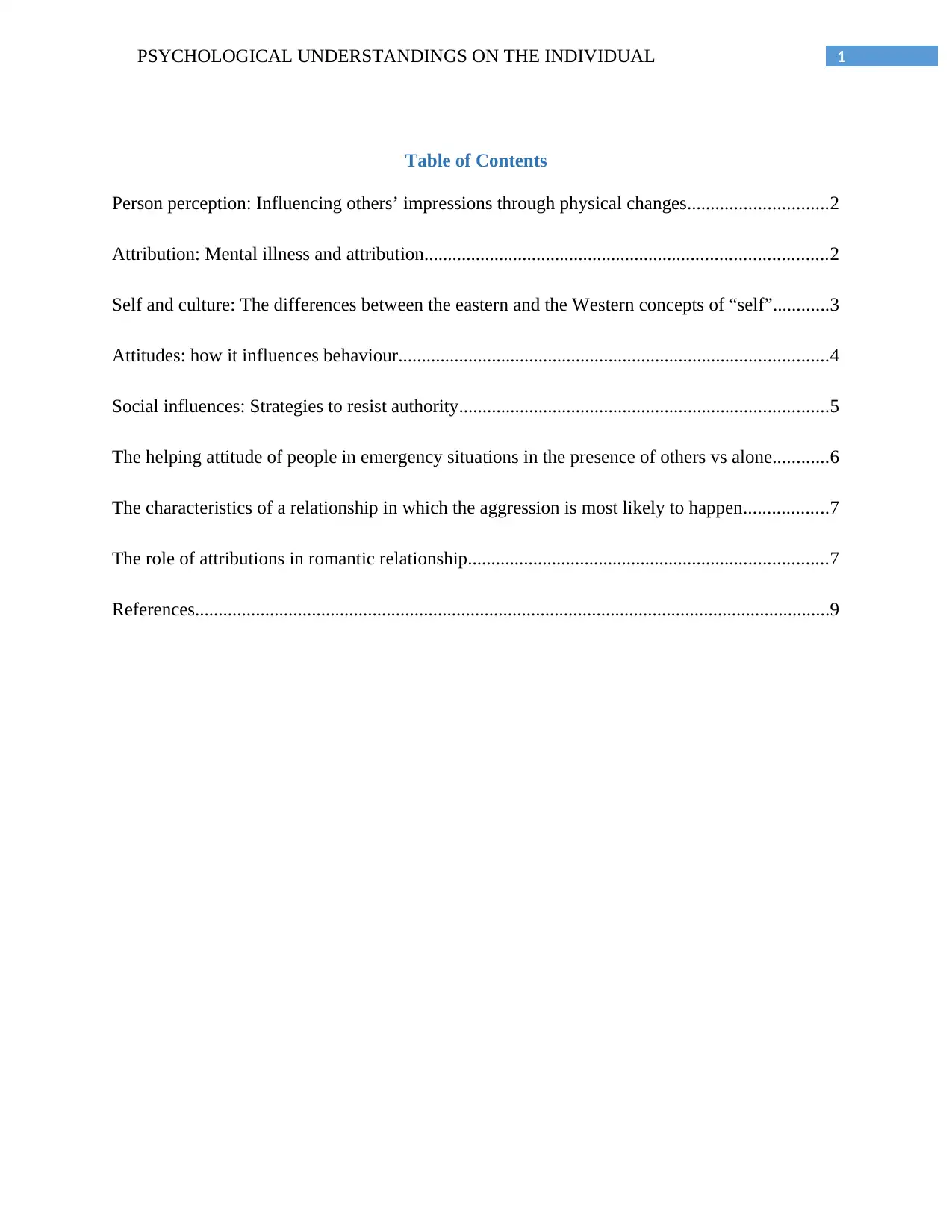
1PSYCHOLOGICAL UNDERSTANDINGS ON THE INDIVIDUAL
Table of Contents
Person perception: Influencing others’ impressions through physical changes..............................2
Attribution: Mental illness and attribution......................................................................................2
Self and culture: The differences between the eastern and the Western concepts of “self”............3
Attitudes: how it influences behaviour............................................................................................4
Social influences: Strategies to resist authority...............................................................................5
The helping attitude of people in emergency situations in the presence of others vs alone............6
The characteristics of a relationship in which the aggression is most likely to happen..................7
The role of attributions in romantic relationship.............................................................................7
References........................................................................................................................................9
Table of Contents
Person perception: Influencing others’ impressions through physical changes..............................2
Attribution: Mental illness and attribution......................................................................................2
Self and culture: The differences between the eastern and the Western concepts of “self”............3
Attitudes: how it influences behaviour............................................................................................4
Social influences: Strategies to resist authority...............................................................................5
The helping attitude of people in emergency situations in the presence of others vs alone............6
The characteristics of a relationship in which the aggression is most likely to happen..................7
The role of attributions in romantic relationship.............................................................................7
References........................................................................................................................................9
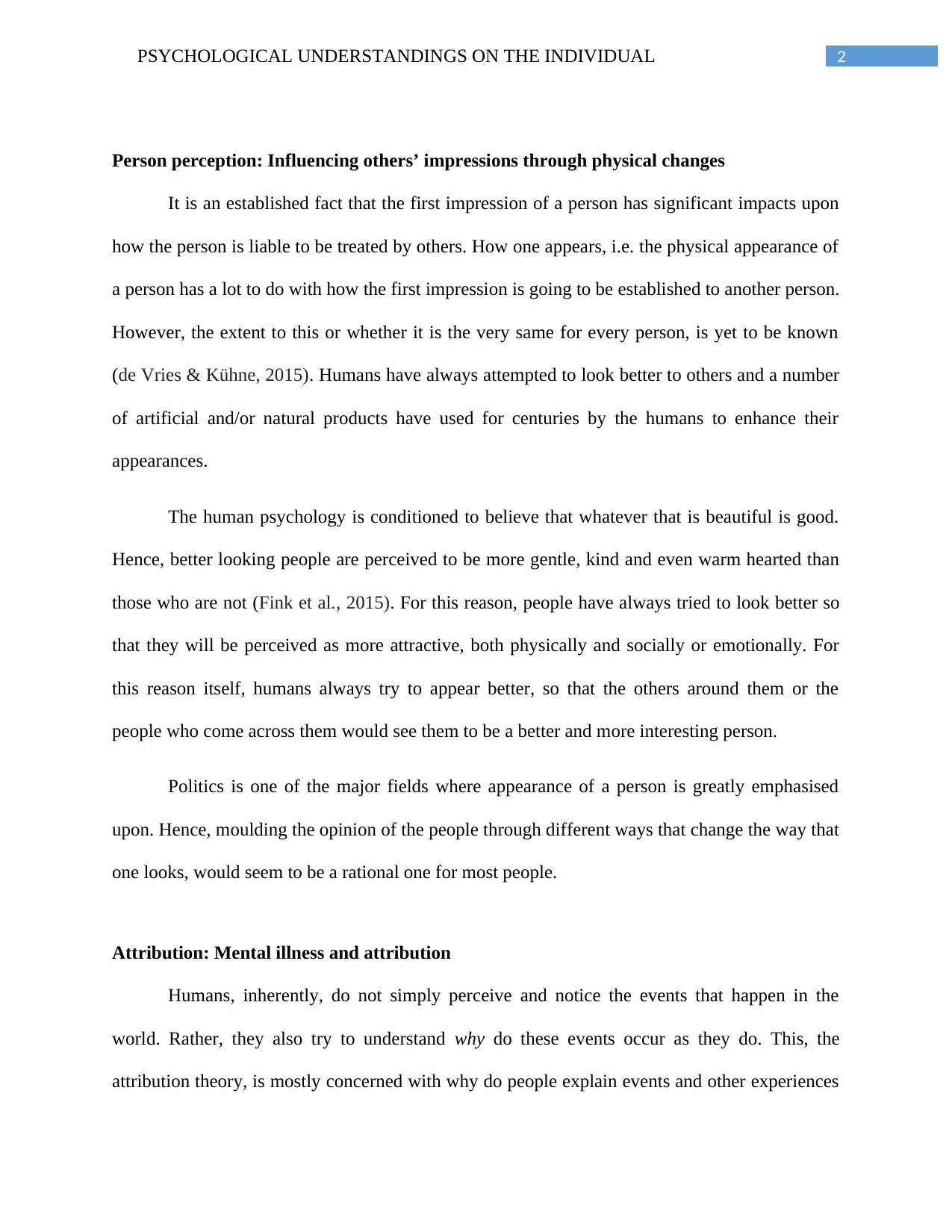
2PSYCHOLOGICAL UNDERSTANDINGS ON THE INDIVIDUAL
Person perception: Influencing others’ impressions through physical changes
It is an established fact that the first impression of a person has significant impacts upon
how the person is liable to be treated by others. How one appears, i.e. the physical appearance of
a person has a lot to do with how the first impression is going to be established to another person.
However, the extent to this or whether it is the very same for every person, is yet to be known
(de Vries & Kühne, 2015). Humans have always attempted to look better to others and a number
of artificial and/or natural products have used for centuries by the humans to enhance their
appearances.
The human psychology is conditioned to believe that whatever that is beautiful is good.
Hence, better looking people are perceived to be more gentle, kind and even warm hearted than
those who are not (Fink et al., 2015). For this reason, people have always tried to look better so
that they will be perceived as more attractive, both physically and socially or emotionally. For
this reason itself, humans always try to appear better, so that the others around them or the
people who come across them would see them to be a better and more interesting person.
Politics is one of the major fields where appearance of a person is greatly emphasised
upon. Hence, moulding the opinion of the people through different ways that change the way that
one looks, would seem to be a rational one for most people.
Attribution: Mental illness and attribution
Humans, inherently, do not simply perceive and notice the events that happen in the
world. Rather, they also try to understand why do these events occur as they do. This, the
attribution theory, is mostly concerned with why do people explain events and other experiences
Person perception: Influencing others’ impressions through physical changes
It is an established fact that the first impression of a person has significant impacts upon
how the person is liable to be treated by others. How one appears, i.e. the physical appearance of
a person has a lot to do with how the first impression is going to be established to another person.
However, the extent to this or whether it is the very same for every person, is yet to be known
(de Vries & Kühne, 2015). Humans have always attempted to look better to others and a number
of artificial and/or natural products have used for centuries by the humans to enhance their
appearances.
The human psychology is conditioned to believe that whatever that is beautiful is good.
Hence, better looking people are perceived to be more gentle, kind and even warm hearted than
those who are not (Fink et al., 2015). For this reason, people have always tried to look better so
that they will be perceived as more attractive, both physically and socially or emotionally. For
this reason itself, humans always try to appear better, so that the others around them or the
people who come across them would see them to be a better and more interesting person.
Politics is one of the major fields where appearance of a person is greatly emphasised
upon. Hence, moulding the opinion of the people through different ways that change the way that
one looks, would seem to be a rational one for most people.
Attribution: Mental illness and attribution
Humans, inherently, do not simply perceive and notice the events that happen in the
world. Rather, they also try to understand why do these events occur as they do. This, the
attribution theory, is mostly concerned with why do people explain events and other experiences
⊘ This is a preview!⊘
Do you want full access?
Subscribe today to unlock all pages.

Trusted by 1+ million students worldwide
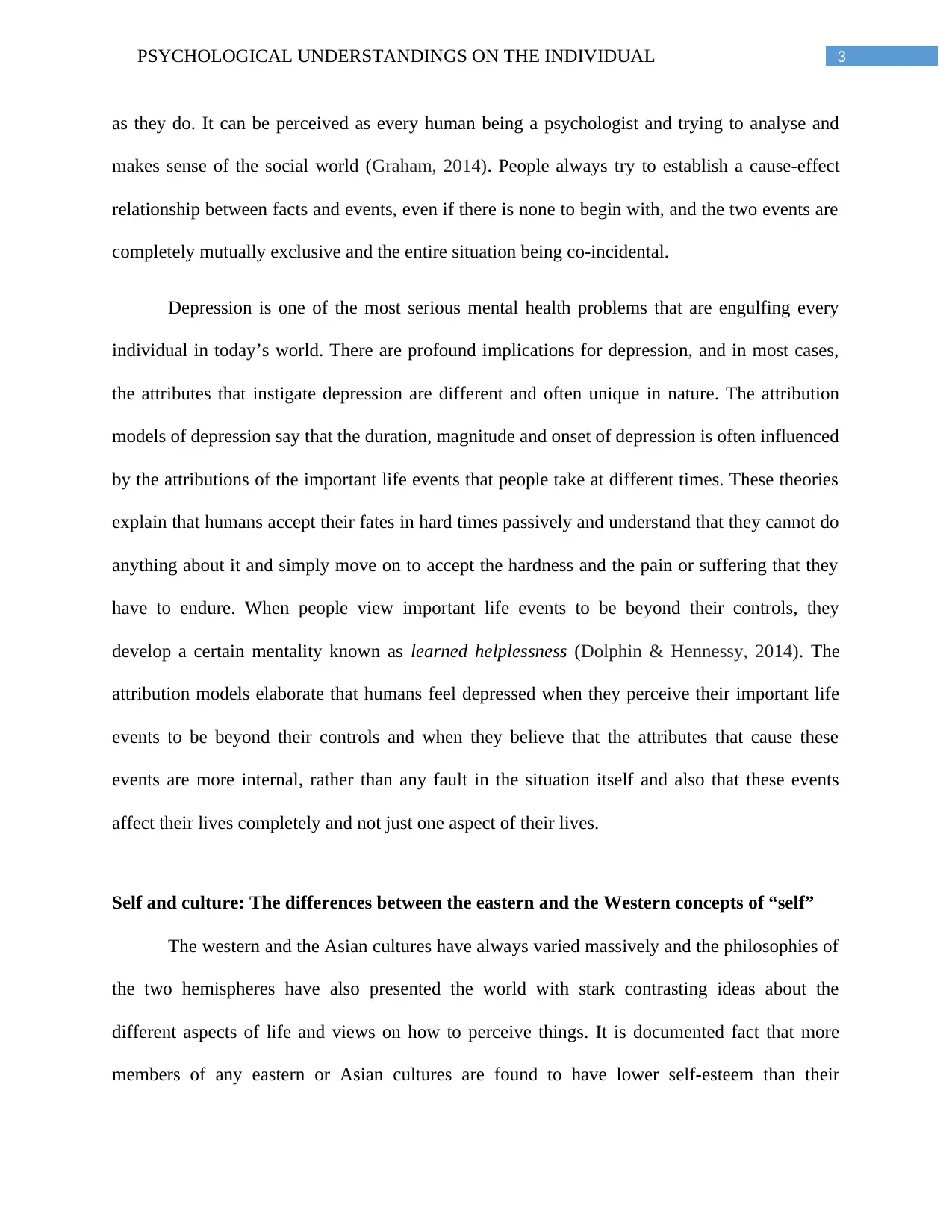
3PSYCHOLOGICAL UNDERSTANDINGS ON THE INDIVIDUAL
as they do. It can be perceived as every human being a psychologist and trying to analyse and
makes sense of the social world (Graham, 2014). People always try to establish a cause-effect
relationship between facts and events, even if there is none to begin with, and the two events are
completely mutually exclusive and the entire situation being co-incidental.
Depression is one of the most serious mental health problems that are engulfing every
individual in today’s world. There are profound implications for depression, and in most cases,
the attributes that instigate depression are different and often unique in nature. The attribution
models of depression say that the duration, magnitude and onset of depression is often influenced
by the attributions of the important life events that people take at different times. These theories
explain that humans accept their fates in hard times passively and understand that they cannot do
anything about it and simply move on to accept the hardness and the pain or suffering that they
have to endure. When people view important life events to be beyond their controls, they
develop a certain mentality known as learned helplessness (Dolphin & Hennessy, 2014). The
attribution models elaborate that humans feel depressed when they perceive their important life
events to be beyond their controls and when they believe that the attributes that cause these
events are more internal, rather than any fault in the situation itself and also that these events
affect their lives completely and not just one aspect of their lives.
Self and culture: The differences between the eastern and the Western concepts of “self”
The western and the Asian cultures have always varied massively and the philosophies of
the two hemispheres have also presented the world with stark contrasting ideas about the
different aspects of life and views on how to perceive things. It is documented fact that more
members of any eastern or Asian cultures are found to have lower self-esteem than their
as they do. It can be perceived as every human being a psychologist and trying to analyse and
makes sense of the social world (Graham, 2014). People always try to establish a cause-effect
relationship between facts and events, even if there is none to begin with, and the two events are
completely mutually exclusive and the entire situation being co-incidental.
Depression is one of the most serious mental health problems that are engulfing every
individual in today’s world. There are profound implications for depression, and in most cases,
the attributes that instigate depression are different and often unique in nature. The attribution
models of depression say that the duration, magnitude and onset of depression is often influenced
by the attributions of the important life events that people take at different times. These theories
explain that humans accept their fates in hard times passively and understand that they cannot do
anything about it and simply move on to accept the hardness and the pain or suffering that they
have to endure. When people view important life events to be beyond their controls, they
develop a certain mentality known as learned helplessness (Dolphin & Hennessy, 2014). The
attribution models elaborate that humans feel depressed when they perceive their important life
events to be beyond their controls and when they believe that the attributes that cause these
events are more internal, rather than any fault in the situation itself and also that these events
affect their lives completely and not just one aspect of their lives.
Self and culture: The differences between the eastern and the Western concepts of “self”
The western and the Asian cultures have always varied massively and the philosophies of
the two hemispheres have also presented the world with stark contrasting ideas about the
different aspects of life and views on how to perceive things. It is documented fact that more
members of any eastern or Asian cultures are found to have lower self-esteem than their
Paraphrase This Document
Need a fresh take? Get an instant paraphrase of this document with our AI Paraphraser
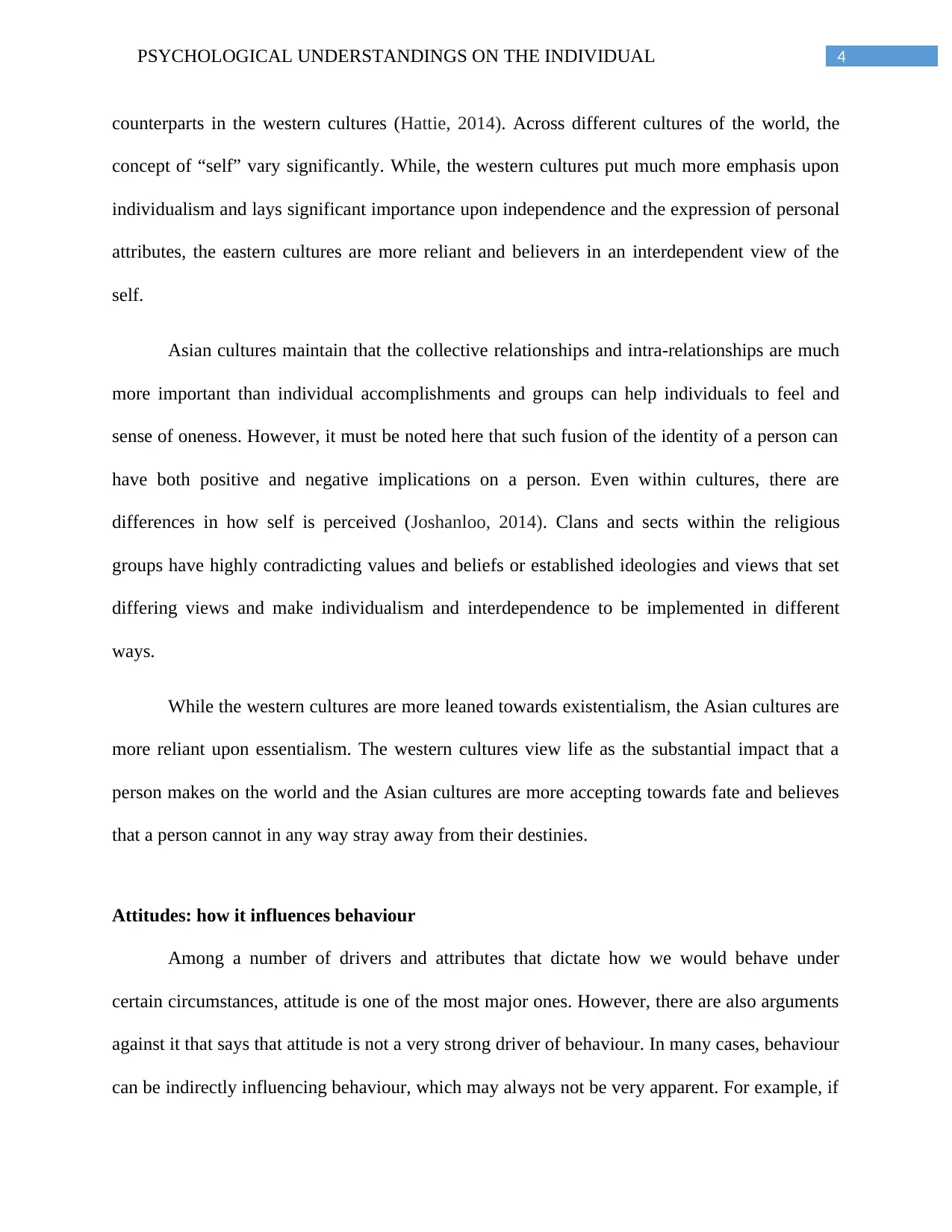
4PSYCHOLOGICAL UNDERSTANDINGS ON THE INDIVIDUAL
counterparts in the western cultures (Hattie, 2014). Across different cultures of the world, the
concept of “self” vary significantly. While, the western cultures put much more emphasis upon
individualism and lays significant importance upon independence and the expression of personal
attributes, the eastern cultures are more reliant and believers in an interdependent view of the
self.
Asian cultures maintain that the collective relationships and intra-relationships are much
more important than individual accomplishments and groups can help individuals to feel and
sense of oneness. However, it must be noted here that such fusion of the identity of a person can
have both positive and negative implications on a person. Even within cultures, there are
differences in how self is perceived (Joshanloo, 2014). Clans and sects within the religious
groups have highly contradicting values and beliefs or established ideologies and views that set
differing views and make individualism and interdependence to be implemented in different
ways.
While the western cultures are more leaned towards existentialism, the Asian cultures are
more reliant upon essentialism. The western cultures view life as the substantial impact that a
person makes on the world and the Asian cultures are more accepting towards fate and believes
that a person cannot in any way stray away from their destinies.
Attitudes: how it influences behaviour
Among a number of drivers and attributes that dictate how we would behave under
certain circumstances, attitude is one of the most major ones. However, there are also arguments
against it that says that attitude is not a very strong driver of behaviour. In many cases, behaviour
can be indirectly influencing behaviour, which may always not be very apparent. For example, if
counterparts in the western cultures (Hattie, 2014). Across different cultures of the world, the
concept of “self” vary significantly. While, the western cultures put much more emphasis upon
individualism and lays significant importance upon independence and the expression of personal
attributes, the eastern cultures are more reliant and believers in an interdependent view of the
self.
Asian cultures maintain that the collective relationships and intra-relationships are much
more important than individual accomplishments and groups can help individuals to feel and
sense of oneness. However, it must be noted here that such fusion of the identity of a person can
have both positive and negative implications on a person. Even within cultures, there are
differences in how self is perceived (Joshanloo, 2014). Clans and sects within the religious
groups have highly contradicting values and beliefs or established ideologies and views that set
differing views and make individualism and interdependence to be implemented in different
ways.
While the western cultures are more leaned towards existentialism, the Asian cultures are
more reliant upon essentialism. The western cultures view life as the substantial impact that a
person makes on the world and the Asian cultures are more accepting towards fate and believes
that a person cannot in any way stray away from their destinies.
Attitudes: how it influences behaviour
Among a number of drivers and attributes that dictate how we would behave under
certain circumstances, attitude is one of the most major ones. However, there are also arguments
against it that says that attitude is not a very strong driver of behaviour. In many cases, behaviour
can be indirectly influencing behaviour, which may always not be very apparent. For example, if
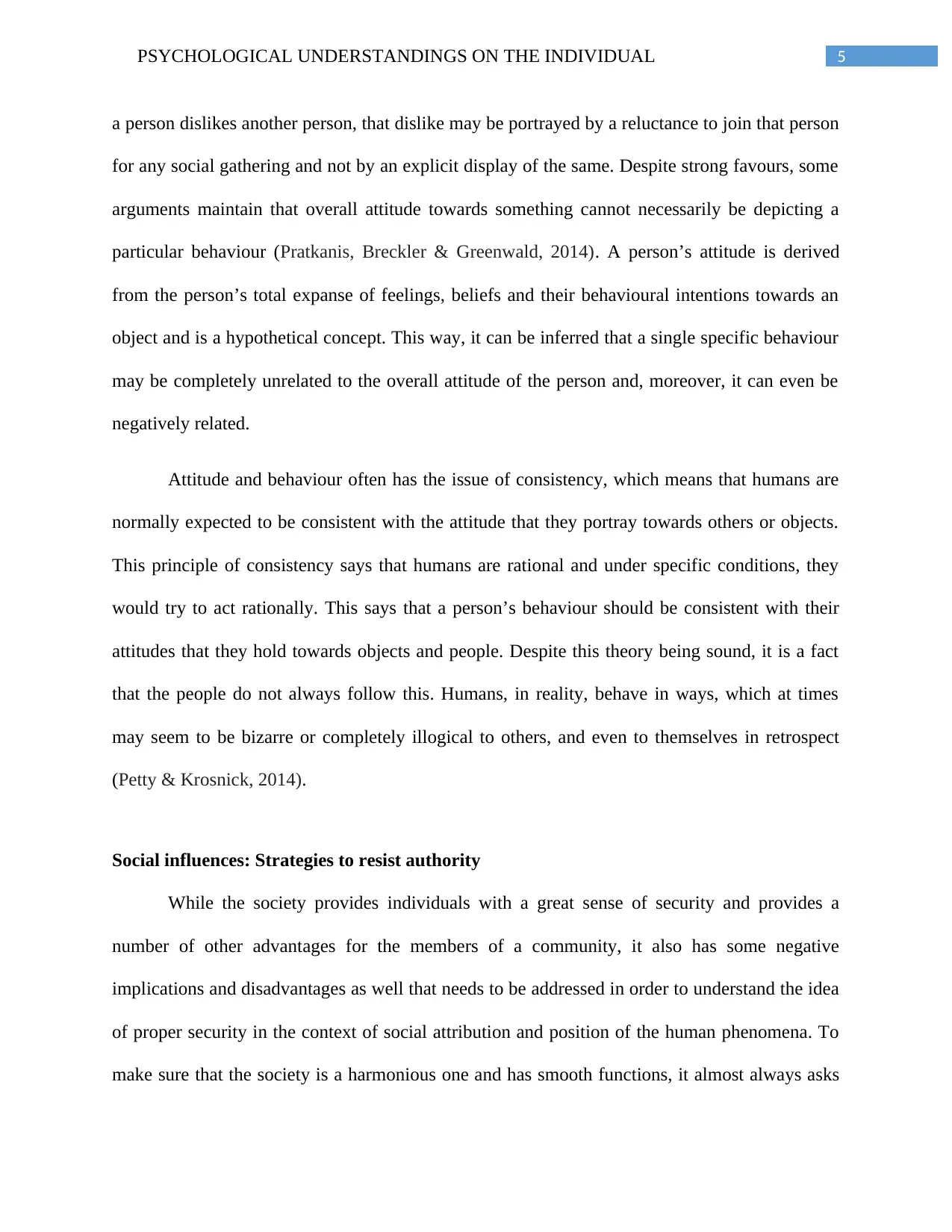
5PSYCHOLOGICAL UNDERSTANDINGS ON THE INDIVIDUAL
a person dislikes another person, that dislike may be portrayed by a reluctance to join that person
for any social gathering and not by an explicit display of the same. Despite strong favours, some
arguments maintain that overall attitude towards something cannot necessarily be depicting a
particular behaviour (Pratkanis, Breckler & Greenwald, 2014). A person’s attitude is derived
from the person’s total expanse of feelings, beliefs and their behavioural intentions towards an
object and is a hypothetical concept. This way, it can be inferred that a single specific behaviour
may be completely unrelated to the overall attitude of the person and, moreover, it can even be
negatively related.
Attitude and behaviour often has the issue of consistency, which means that humans are
normally expected to be consistent with the attitude that they portray towards others or objects.
This principle of consistency says that humans are rational and under specific conditions, they
would try to act rationally. This says that a person’s behaviour should be consistent with their
attitudes that they hold towards objects and people. Despite this theory being sound, it is a fact
that the people do not always follow this. Humans, in reality, behave in ways, which at times
may seem to be bizarre or completely illogical to others, and even to themselves in retrospect
(Petty & Krosnick, 2014).
Social influences: Strategies to resist authority
While the society provides individuals with a great sense of security and provides a
number of other advantages for the members of a community, it also has some negative
implications and disadvantages as well that needs to be addressed in order to understand the idea
of proper security in the context of social attribution and position of the human phenomena. To
make sure that the society is a harmonious one and has smooth functions, it almost always asks
a person dislikes another person, that dislike may be portrayed by a reluctance to join that person
for any social gathering and not by an explicit display of the same. Despite strong favours, some
arguments maintain that overall attitude towards something cannot necessarily be depicting a
particular behaviour (Pratkanis, Breckler & Greenwald, 2014). A person’s attitude is derived
from the person’s total expanse of feelings, beliefs and their behavioural intentions towards an
object and is a hypothetical concept. This way, it can be inferred that a single specific behaviour
may be completely unrelated to the overall attitude of the person and, moreover, it can even be
negatively related.
Attitude and behaviour often has the issue of consistency, which means that humans are
normally expected to be consistent with the attitude that they portray towards others or objects.
This principle of consistency says that humans are rational and under specific conditions, they
would try to act rationally. This says that a person’s behaviour should be consistent with their
attitudes that they hold towards objects and people. Despite this theory being sound, it is a fact
that the people do not always follow this. Humans, in reality, behave in ways, which at times
may seem to be bizarre or completely illogical to others, and even to themselves in retrospect
(Petty & Krosnick, 2014).
Social influences: Strategies to resist authority
While the society provides individuals with a great sense of security and provides a
number of other advantages for the members of a community, it also has some negative
implications and disadvantages as well that needs to be addressed in order to understand the idea
of proper security in the context of social attribution and position of the human phenomena. To
make sure that the society is a harmonious one and has smooth functions, it almost always asks
⊘ This is a preview!⊘
Do you want full access?
Subscribe today to unlock all pages.

Trusted by 1+ million students worldwide
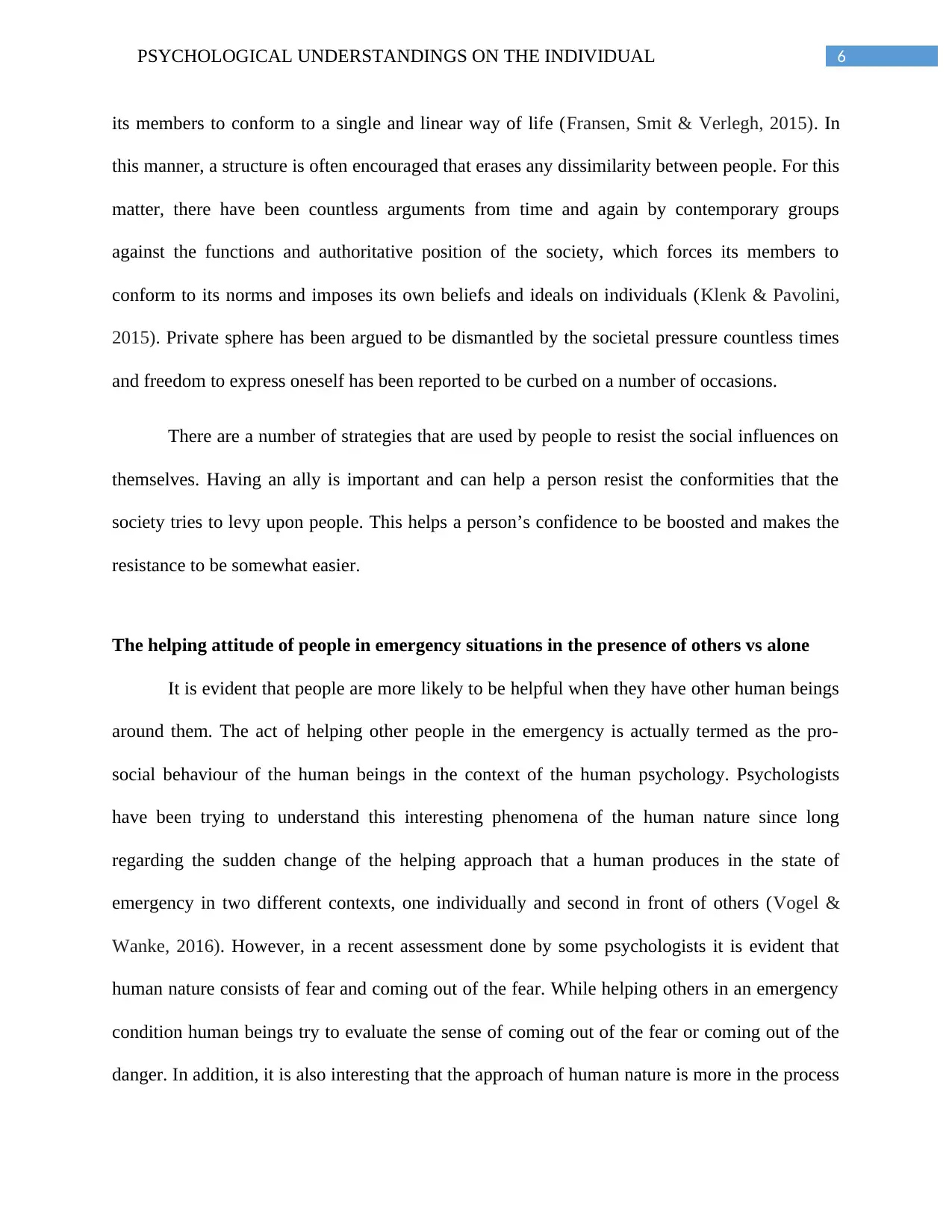
6PSYCHOLOGICAL UNDERSTANDINGS ON THE INDIVIDUAL
its members to conform to a single and linear way of life (Fransen, Smit & Verlegh, 2015). In
this manner, a structure is often encouraged that erases any dissimilarity between people. For this
matter, there have been countless arguments from time and again by contemporary groups
against the functions and authoritative position of the society, which forces its members to
conform to its norms and imposes its own beliefs and ideals on individuals (Klenk & Pavolini,
2015). Private sphere has been argued to be dismantled by the societal pressure countless times
and freedom to express oneself has been reported to be curbed on a number of occasions.
There are a number of strategies that are used by people to resist the social influences on
themselves. Having an ally is important and can help a person resist the conformities that the
society tries to levy upon people. This helps a person’s confidence to be boosted and makes the
resistance to be somewhat easier.
The helping attitude of people in emergency situations in the presence of others vs alone
It is evident that people are more likely to be helpful when they have other human beings
around them. The act of helping other people in the emergency is actually termed as the pro-
social behaviour of the human beings in the context of the human psychology. Psychologists
have been trying to understand this interesting phenomena of the human nature since long
regarding the sudden change of the helping approach that a human produces in the state of
emergency in two different contexts, one individually and second in front of others (Vogel &
Wanke, 2016). However, in a recent assessment done by some psychologists it is evident that
human nature consists of fear and coming out of the fear. While helping others in an emergency
condition human beings try to evaluate the sense of coming out of the fear or coming out of the
danger. In addition, it is also interesting that the approach of human nature is more in the process
its members to conform to a single and linear way of life (Fransen, Smit & Verlegh, 2015). In
this manner, a structure is often encouraged that erases any dissimilarity between people. For this
matter, there have been countless arguments from time and again by contemporary groups
against the functions and authoritative position of the society, which forces its members to
conform to its norms and imposes its own beliefs and ideals on individuals (Klenk & Pavolini,
2015). Private sphere has been argued to be dismantled by the societal pressure countless times
and freedom to express oneself has been reported to be curbed on a number of occasions.
There are a number of strategies that are used by people to resist the social influences on
themselves. Having an ally is important and can help a person resist the conformities that the
society tries to levy upon people. This helps a person’s confidence to be boosted and makes the
resistance to be somewhat easier.
The helping attitude of people in emergency situations in the presence of others vs alone
It is evident that people are more likely to be helpful when they have other human beings
around them. The act of helping other people in the emergency is actually termed as the pro-
social behaviour of the human beings in the context of the human psychology. Psychologists
have been trying to understand this interesting phenomena of the human nature since long
regarding the sudden change of the helping approach that a human produces in the state of
emergency in two different contexts, one individually and second in front of others (Vogel &
Wanke, 2016). However, in a recent assessment done by some psychologists it is evident that
human nature consists of fear and coming out of the fear. While helping others in an emergency
condition human beings try to evaluate the sense of coming out of the fear or coming out of the
danger. In addition, it is also interesting that the approach of human nature is more in the process
Paraphrase This Document
Need a fresh take? Get an instant paraphrase of this document with our AI Paraphraser
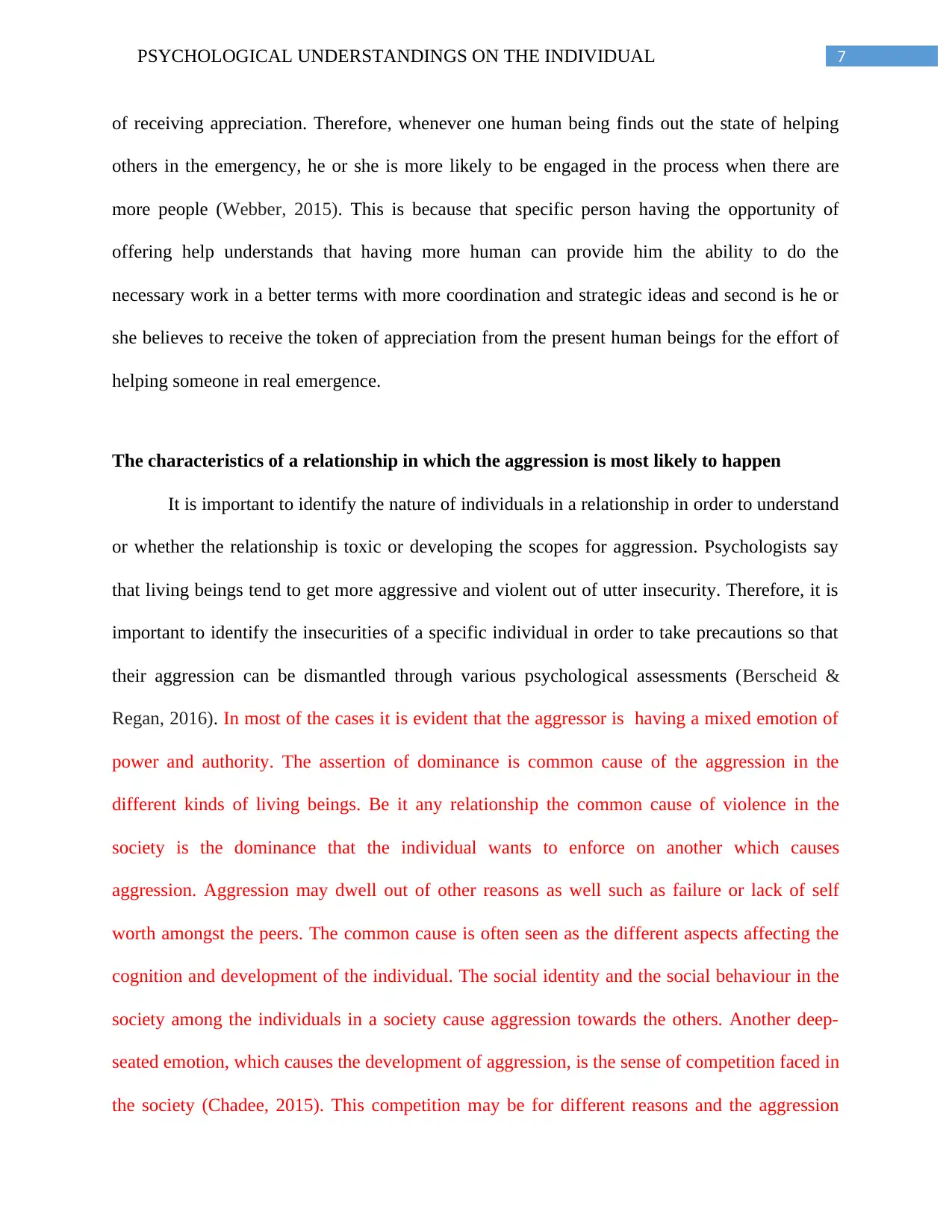
7PSYCHOLOGICAL UNDERSTANDINGS ON THE INDIVIDUAL
of receiving appreciation. Therefore, whenever one human being finds out the state of helping
others in the emergency, he or she is more likely to be engaged in the process when there are
more people (Webber, 2015). This is because that specific person having the opportunity of
offering help understands that having more human can provide him the ability to do the
necessary work in a better terms with more coordination and strategic ideas and second is he or
she believes to receive the token of appreciation from the present human beings for the effort of
helping someone in real emergence.
The characteristics of a relationship in which the aggression is most likely to happen
It is important to identify the nature of individuals in a relationship in order to understand
or whether the relationship is toxic or developing the scopes for aggression. Psychologists say
that living beings tend to get more aggressive and violent out of utter insecurity. Therefore, it is
important to identify the insecurities of a specific individual in order to take precautions so that
their aggression can be dismantled through various psychological assessments (Berscheid &
Regan, 2016). In most of the cases it is evident that the aggressor is having a mixed emotion of
power and authority. The assertion of dominance is common cause of the aggression in the
different kinds of living beings. Be it any relationship the common cause of violence in the
society is the dominance that the individual wants to enforce on another which causes
aggression. Aggression may dwell out of other reasons as well such as failure or lack of self
worth amongst the peers. The common cause is often seen as the different aspects affecting the
cognition and development of the individual. The social identity and the social behaviour in the
society among the individuals in a society cause aggression towards the others. Another deep-
seated emotion, which causes the development of aggression, is the sense of competition faced in
the society (Chadee, 2015). This competition may be for different reasons and the aggression
of receiving appreciation. Therefore, whenever one human being finds out the state of helping
others in the emergency, he or she is more likely to be engaged in the process when there are
more people (Webber, 2015). This is because that specific person having the opportunity of
offering help understands that having more human can provide him the ability to do the
necessary work in a better terms with more coordination and strategic ideas and second is he or
she believes to receive the token of appreciation from the present human beings for the effort of
helping someone in real emergence.
The characteristics of a relationship in which the aggression is most likely to happen
It is important to identify the nature of individuals in a relationship in order to understand
or whether the relationship is toxic or developing the scopes for aggression. Psychologists say
that living beings tend to get more aggressive and violent out of utter insecurity. Therefore, it is
important to identify the insecurities of a specific individual in order to take precautions so that
their aggression can be dismantled through various psychological assessments (Berscheid &
Regan, 2016). In most of the cases it is evident that the aggressor is having a mixed emotion of
power and authority. The assertion of dominance is common cause of the aggression in the
different kinds of living beings. Be it any relationship the common cause of violence in the
society is the dominance that the individual wants to enforce on another which causes
aggression. Aggression may dwell out of other reasons as well such as failure or lack of self
worth amongst the peers. The common cause is often seen as the different aspects affecting the
cognition and development of the individual. The social identity and the social behaviour in the
society among the individuals in a society cause aggression towards the others. Another deep-
seated emotion, which causes the development of aggression, is the sense of competition faced in
the society (Chadee, 2015). This competition may be for different reasons and the aggression
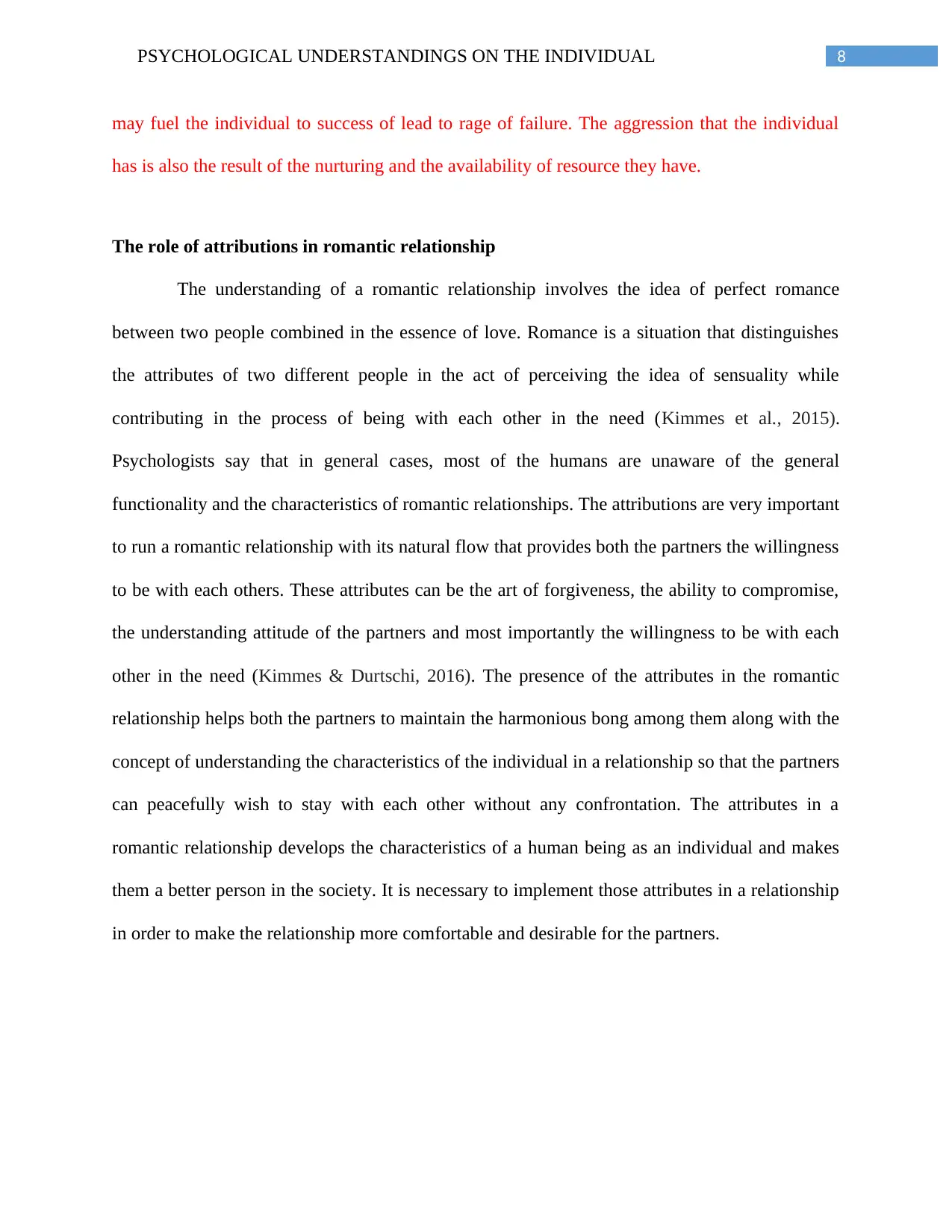
8PSYCHOLOGICAL UNDERSTANDINGS ON THE INDIVIDUAL
may fuel the individual to success of lead to rage of failure. The aggression that the individual
has is also the result of the nurturing and the availability of resource they have.
The role of attributions in romantic relationship
The understanding of a romantic relationship involves the idea of perfect romance
between two people combined in the essence of love. Romance is a situation that distinguishes
the attributes of two different people in the act of perceiving the idea of sensuality while
contributing in the process of being with each other in the need (Kimmes et al., 2015).
Psychologists say that in general cases, most of the humans are unaware of the general
functionality and the characteristics of romantic relationships. The attributions are very important
to run a romantic relationship with its natural flow that provides both the partners the willingness
to be with each others. These attributes can be the art of forgiveness, the ability to compromise,
the understanding attitude of the partners and most importantly the willingness to be with each
other in the need (Kimmes & Durtschi, 2016). The presence of the attributes in the romantic
relationship helps both the partners to maintain the harmonious bong among them along with the
concept of understanding the characteristics of the individual in a relationship so that the partners
can peacefully wish to stay with each other without any confrontation. The attributes in a
romantic relationship develops the characteristics of a human being as an individual and makes
them a better person in the society. It is necessary to implement those attributes in a relationship
in order to make the relationship more comfortable and desirable for the partners.
may fuel the individual to success of lead to rage of failure. The aggression that the individual
has is also the result of the nurturing and the availability of resource they have.
The role of attributions in romantic relationship
The understanding of a romantic relationship involves the idea of perfect romance
between two people combined in the essence of love. Romance is a situation that distinguishes
the attributes of two different people in the act of perceiving the idea of sensuality while
contributing in the process of being with each other in the need (Kimmes et al., 2015).
Psychologists say that in general cases, most of the humans are unaware of the general
functionality and the characteristics of romantic relationships. The attributions are very important
to run a romantic relationship with its natural flow that provides both the partners the willingness
to be with each others. These attributes can be the art of forgiveness, the ability to compromise,
the understanding attitude of the partners and most importantly the willingness to be with each
other in the need (Kimmes & Durtschi, 2016). The presence of the attributes in the romantic
relationship helps both the partners to maintain the harmonious bong among them along with the
concept of understanding the characteristics of the individual in a relationship so that the partners
can peacefully wish to stay with each other without any confrontation. The attributes in a
romantic relationship develops the characteristics of a human being as an individual and makes
them a better person in the society. It is necessary to implement those attributes in a relationship
in order to make the relationship more comfortable and desirable for the partners.
⊘ This is a preview!⊘
Do you want full access?
Subscribe today to unlock all pages.

Trusted by 1+ million students worldwide
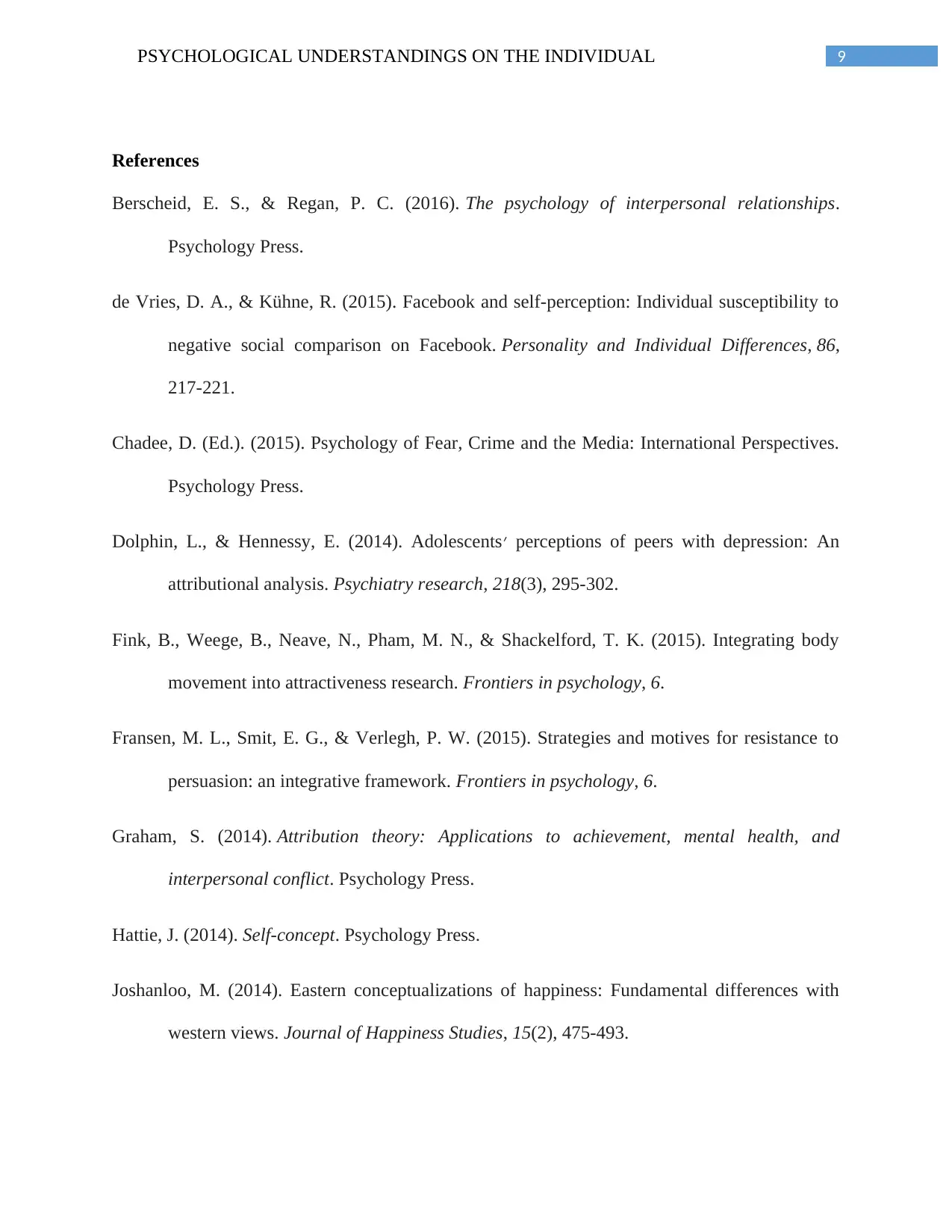
9PSYCHOLOGICAL UNDERSTANDINGS ON THE INDIVIDUAL
References
Berscheid, E. S., & Regan, P. C. (2016). The psychology of interpersonal relationships.
Psychology Press.
de Vries, D. A., & Kühne, R. (2015). Facebook and self-perception: Individual susceptibility to
negative social comparison on Facebook. Personality and Individual Differences, 86,
217-221.
Chadee, D. (Ed.). (2015). Psychology of Fear, Crime and the Media: International Perspectives.
Psychology Press.
Dolphin, L., & Hennessy, E. (2014). Adolescents׳ perceptions of peers with depression: An
attributional analysis. Psychiatry research, 218(3), 295-302.
Fink, B., Weege, B., Neave, N., Pham, M. N., & Shackelford, T. K. (2015). Integrating body
movement into attractiveness research. Frontiers in psychology, 6.
Fransen, M. L., Smit, E. G., & Verlegh, P. W. (2015). Strategies and motives for resistance to
persuasion: an integrative framework. Frontiers in psychology, 6.
Graham, S. (2014). Attribution theory: Applications to achievement, mental health, and
interpersonal conflict. Psychology Press.
Hattie, J. (2014). Self-concept. Psychology Press.
Joshanloo, M. (2014). Eastern conceptualizations of happiness: Fundamental differences with
western views. Journal of Happiness Studies, 15(2), 475-493.
References
Berscheid, E. S., & Regan, P. C. (2016). The psychology of interpersonal relationships.
Psychology Press.
de Vries, D. A., & Kühne, R. (2015). Facebook and self-perception: Individual susceptibility to
negative social comparison on Facebook. Personality and Individual Differences, 86,
217-221.
Chadee, D. (Ed.). (2015). Psychology of Fear, Crime and the Media: International Perspectives.
Psychology Press.
Dolphin, L., & Hennessy, E. (2014). Adolescents׳ perceptions of peers with depression: An
attributional analysis. Psychiatry research, 218(3), 295-302.
Fink, B., Weege, B., Neave, N., Pham, M. N., & Shackelford, T. K. (2015). Integrating body
movement into attractiveness research. Frontiers in psychology, 6.
Fransen, M. L., Smit, E. G., & Verlegh, P. W. (2015). Strategies and motives for resistance to
persuasion: an integrative framework. Frontiers in psychology, 6.
Graham, S. (2014). Attribution theory: Applications to achievement, mental health, and
interpersonal conflict. Psychology Press.
Hattie, J. (2014). Self-concept. Psychology Press.
Joshanloo, M. (2014). Eastern conceptualizations of happiness: Fundamental differences with
western views. Journal of Happiness Studies, 15(2), 475-493.
Paraphrase This Document
Need a fresh take? Get an instant paraphrase of this document with our AI Paraphraser
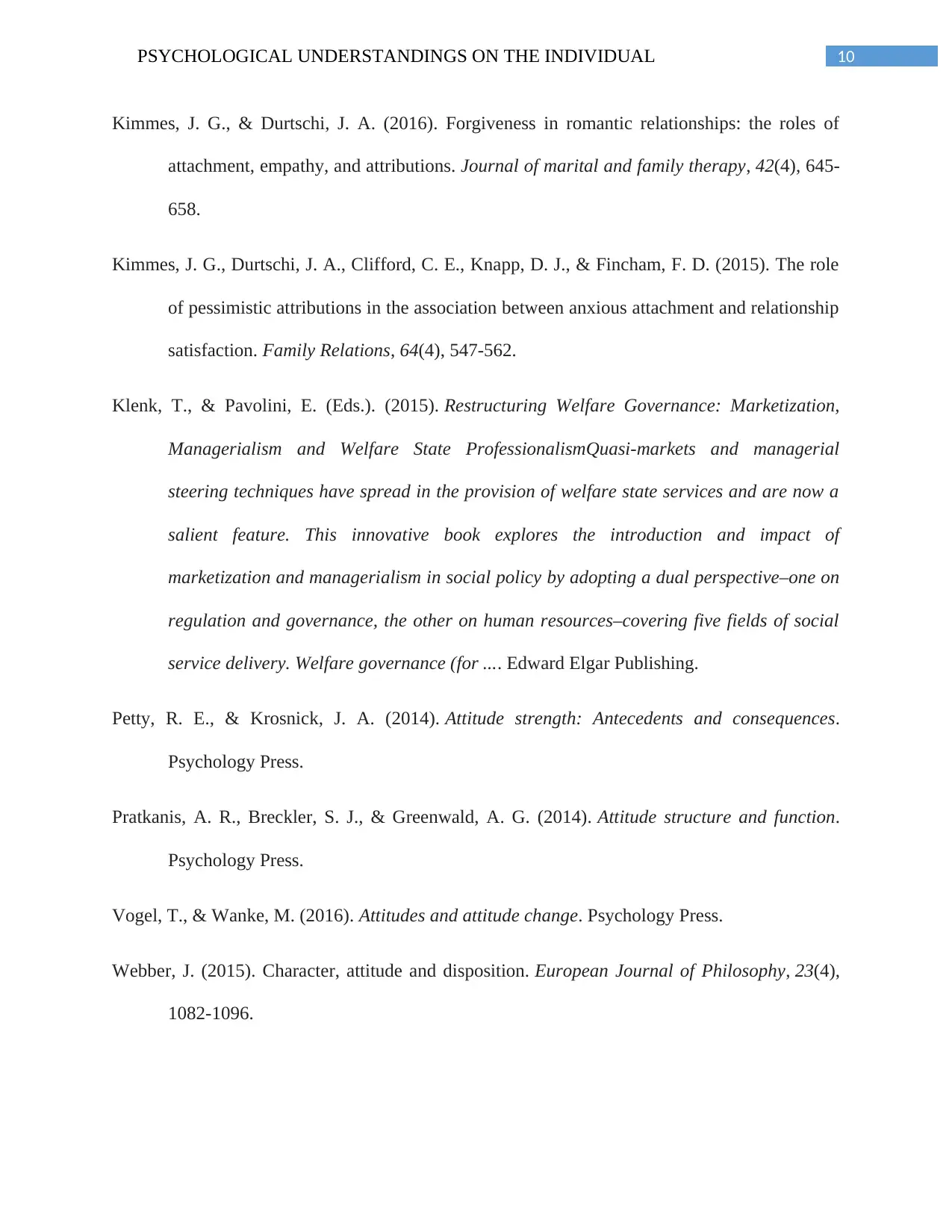
10PSYCHOLOGICAL UNDERSTANDINGS ON THE INDIVIDUAL
Kimmes, J. G., & Durtschi, J. A. (2016). Forgiveness in romantic relationships: the roles of
attachment, empathy, and attributions. Journal of marital and family therapy, 42(4), 645-
658.
Kimmes, J. G., Durtschi, J. A., Clifford, C. E., Knapp, D. J., & Fincham, F. D. (2015). The role
of pessimistic attributions in the association between anxious attachment and relationship
satisfaction. Family Relations, 64(4), 547-562.
Klenk, T., & Pavolini, E. (Eds.). (2015). Restructuring Welfare Governance: Marketization,
Managerialism and Welfare State ProfessionalismQuasi-markets and managerial
steering techniques have spread in the provision of welfare state services and are now a
salient feature. This innovative book explores the introduction and impact of
marketization and managerialism in social policy by adopting a dual perspective–one on
regulation and governance, the other on human resources–covering five fields of social
service delivery. Welfare governance (for .... Edward Elgar Publishing.
Petty, R. E., & Krosnick, J. A. (2014). Attitude strength: Antecedents and consequences.
Psychology Press.
Pratkanis, A. R., Breckler, S. J., & Greenwald, A. G. (2014). Attitude structure and function.
Psychology Press.
Vogel, T., & Wanke, M. (2016). Attitudes and attitude change. Psychology Press.
Webber, J. (2015). Character, attitude and disposition. European Journal of Philosophy, 23(4),
1082-1096.
Kimmes, J. G., & Durtschi, J. A. (2016). Forgiveness in romantic relationships: the roles of
attachment, empathy, and attributions. Journal of marital and family therapy, 42(4), 645-
658.
Kimmes, J. G., Durtschi, J. A., Clifford, C. E., Knapp, D. J., & Fincham, F. D. (2015). The role
of pessimistic attributions in the association between anxious attachment and relationship
satisfaction. Family Relations, 64(4), 547-562.
Klenk, T., & Pavolini, E. (Eds.). (2015). Restructuring Welfare Governance: Marketization,
Managerialism and Welfare State ProfessionalismQuasi-markets and managerial
steering techniques have spread in the provision of welfare state services and are now a
salient feature. This innovative book explores the introduction and impact of
marketization and managerialism in social policy by adopting a dual perspective–one on
regulation and governance, the other on human resources–covering five fields of social
service delivery. Welfare governance (for .... Edward Elgar Publishing.
Petty, R. E., & Krosnick, J. A. (2014). Attitude strength: Antecedents and consequences.
Psychology Press.
Pratkanis, A. R., Breckler, S. J., & Greenwald, A. G. (2014). Attitude structure and function.
Psychology Press.
Vogel, T., & Wanke, M. (2016). Attitudes and attitude change. Psychology Press.
Webber, J. (2015). Character, attitude and disposition. European Journal of Philosophy, 23(4),
1082-1096.
1 out of 11
Related Documents
Your All-in-One AI-Powered Toolkit for Academic Success.
+13062052269
info@desklib.com
Available 24*7 on WhatsApp / Email
![[object Object]](/_next/static/media/star-bottom.7253800d.svg)
Unlock your academic potential
Copyright © 2020–2025 A2Z Services. All Rights Reserved. Developed and managed by ZUCOL.





